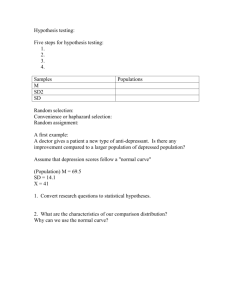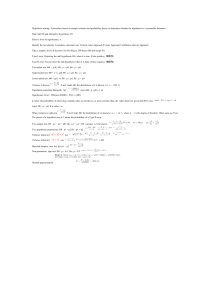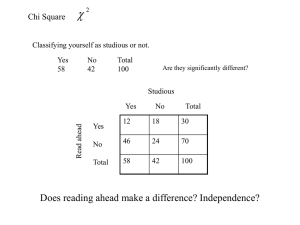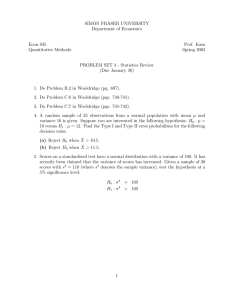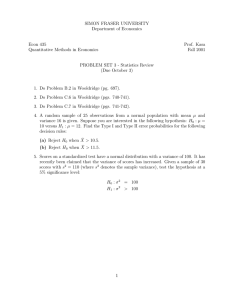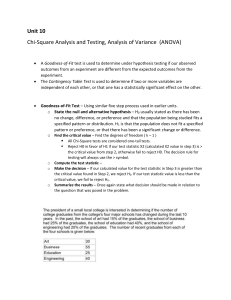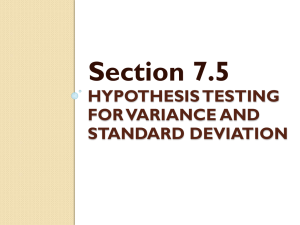Statistics 2 Formula AQA
advertisement
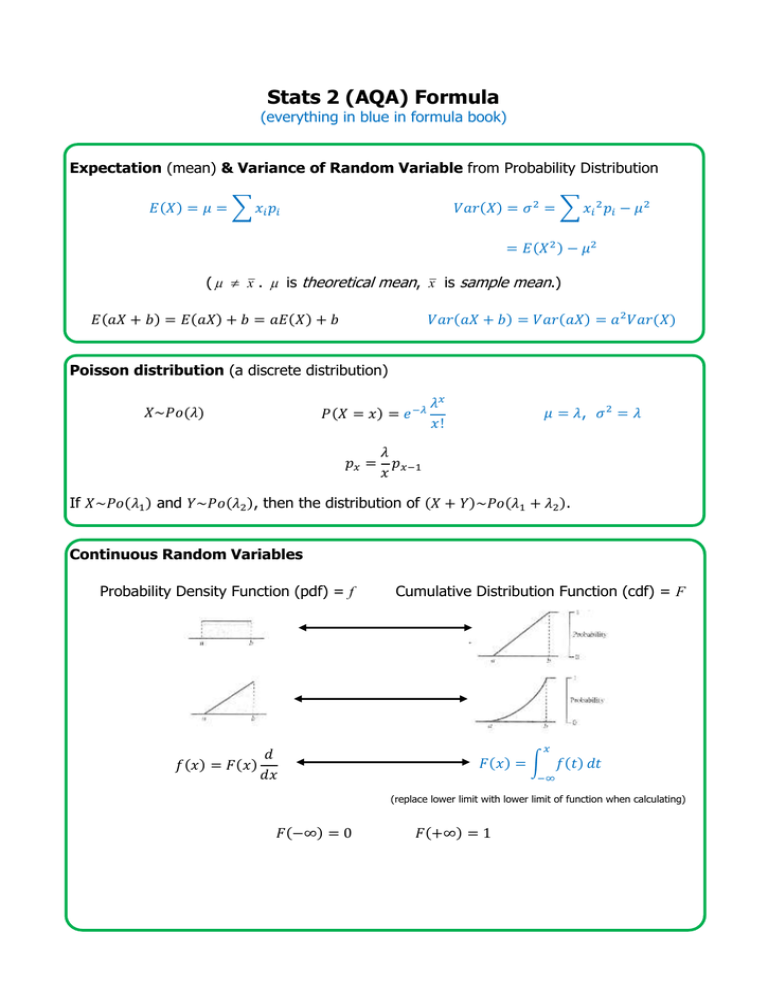
Stats 2 (AQA) Formula (everything in blue in formula book) Expectation (mean) & Variance of Random Variable from Probability Distribution 𝑉𝑎𝑟(𝑋) = 𝜎 2 = ∑ 𝑥𝑖 2 𝑝𝑖 − 𝜇 2 𝐸(𝑋) = 𝜇 = ∑ 𝑥𝑖 𝑝𝑖 = 𝐸(𝑋 2 ) − 𝜇 2 ( x . is theoretical mean, x is sample mean.) 𝑉𝑎𝑟(𝑎𝑋 + 𝑏) = 𝑉𝑎𝑟(𝑎𝑋) = 𝑎2 𝑉𝑎𝑟(𝑋) 𝐸(𝑎𝑋 + 𝑏) = 𝐸(𝑎𝑋) + 𝑏 = 𝑎𝐸(𝑋) + 𝑏 Poisson distribution (a discrete distribution) 𝑃(𝑋 = 𝑥) = 𝑒 −𝜆 𝑋~𝑃𝑜(𝜆) 𝑝𝑥 = 𝜆𝑥 𝑥! 𝜇 = 𝜆, 𝜎 2 = 𝜆 𝜆 𝑝 𝑥 𝑥−1 If 𝑋~𝑃𝑜(𝜆1 ) and 𝑌~𝑃𝑜(𝜆2 ), then the distribution of (𝑋 + 𝑌)~𝑃𝑜(𝜆1 + 𝜆2 ). Continuous Random Variables Probability Density Function (pdf) = f Cumulative Distribution Function (cdf) = F 𝑑 𝑓(𝑥) = 𝐹(𝑥) 𝑑𝑥 𝐹(𝑥) = ∫ 𝑓(𝑡) 𝑑𝑡 𝑥 −∞ (replace lower limit with lower limit of function when calculating) 𝐹(−∞) = 0 𝐹(+∞) = 1 Three methods to find specific probabilities of X: 𝑑 1. 𝑃(𝑐 < 𝑋 < 𝑑) = ∫𝑐 𝑓(𝑥) 𝑑𝑥 (ie integrate to find area between two values) 2. Having integrated, evaluate between limits (similar to finding normal distribution probabilities). 𝑃(𝑐 < 𝑋 < 𝑑) = 𝐹(𝑑) − 𝐹(𝑐) 𝐹(𝑋 > 𝑑) = 1 − 𝐹(𝑑) 3. Use geometry of graph of 𝑓(𝑥) (where possible, splitting it into triangles, trapezia etc). To find median value, m, solve for m either: 𝑚 or 0.5 = ∫−∞ 𝑓(𝑥)𝑑𝑥 0.5 = 𝐹(𝑚) To find, for example, the value at 95th percentile, solve for d; 𝑑 or 0.95 = ∫−∞ 𝑓(𝑥)𝑑𝑥 Mean and variance… 0.95 = 𝐹(𝑑) ∞ 𝐸(𝑋) = 𝜇 = ∫ 𝑥𝑓(𝑥) 𝑑𝑥 −∞ ∞ 2 𝐸(𝑋 2 ) = ∫ 𝑥 𝑓(𝑥) 𝑑𝑥 −∞ ∞ 𝐸(𝑔(𝑋)) = ∫ 𝑔(𝑥)𝑓(𝑥) 𝑑𝑥 −∞ If distribution is symmetrical then 𝐸(𝑋) = 𝑐𝑒𝑛𝑡𝑟𝑎𝑙 𝑣𝑎𝑙𝑢𝑒. ∞ 𝑉𝑎𝑟(𝑋) = 𝐸(𝑋 2 ) − 𝜇 2 = ∫ 𝑥 2 𝑓(𝑥) 𝑑𝑥 − 𝜇 2 −∞ Rectangular (Uniform) Distribution 𝑓(𝑥) = 1 𝐸(𝑋) = (𝑎 + 𝑏) 2 1 𝑏−𝑎 𝑉𝑎𝑟(𝑋) = 𝐹(𝑥) = 1 (𝑏 − 𝑎)2 12 𝑥−𝑎 𝑏−𝑎 Estimation The t distribution (two random variables, 𝑋̅ and 𝑆, i.e. unknown population variance). 𝑇= 𝑋̅ − 𝜇 𝑆 √𝑛 𝑇~𝑡𝜈 or 𝑇~𝑡𝑛−1 𝜈 = 𝑛𝑢𝑚𝑏𝑒𝑟 𝑜𝑓 𝑑𝑒𝑔𝑟𝑒𝑒𝑠 𝑜𝑓 𝑓𝑟𝑒𝑒𝑑𝑜𝑚 = 𝑛 − 1 (parameter 𝜈 pronounced ‘nu’) Confidence intervals given by 𝑥̅ ± "c" 𝑠 √𝑛 𝑠2 𝑥̅ ± "c"√ 𝑛 Hypothesis Testing Null Hypothesis 𝐻0 : 𝜇 = 435 Alternative Hypothesis 𝐻1 : 𝜇 < 435 One tailed 𝐻1 : 𝜇 ≠ 435 Two tailed Acceptance of null hypothesis does not mean it is true, rather that the data provides no evidence to prefer the alternative. Type 1 error – to reject H0 (and accept H1) when H0 is actually true. Type 2 error – to reject H1 (and accept H0) when H1 is actually true. 𝑃(𝑇𝑦𝑝𝑒 1 𝑒𝑟𝑟𝑜𝑟) = 𝑠𝑖𝑔𝑛𝑖𝑓𝑖𝑐𝑎𝑛𝑐𝑒 𝑙𝑒𝑣𝑒𝑙 Test Procedure: 1. Write down the two hypotheses. 2. Identify an appropriate test statistic and the distribution of the corresponding random variable. 3. Identify the significance level (usually given). This is also 𝑃(𝑇𝑦𝑝𝑒 1 𝑒𝑟𝑟𝑜𝑟). 4. Determine the critical region (should be done before collecting data). 5. Calculate the value of the test statistic. 6. Determine and clarify in context the outcome of the test. 𝝌𝟐 Contingency Tables Tests Part A – The 𝝌𝟐 Distribution 𝑋 2 ~𝜒𝜈2 𝜎 2 = 2𝜈 (where 𝜐 = 𝑚 − 1) 𝜇=𝜐 𝑚 (𝑂𝑖 − 𝐸𝑖 )2 𝑋 =∑ 𝐸𝑖 2 𝑖=1 (where 𝑚 = number of different possible outcomes) All expected frequencies must be greater than 5 Part B – Contingency Tables Associated vs independent To calculate expected frequencies from observed frequencies use 𝑟𝑜𝑤 𝑡𝑜𝑡𝑎𝑙 × 𝑐𝑜𝑙𝑢𝑚𝑛 𝑡𝑜𝑡𝑎𝑙 𝑔𝑟𝑎𝑛𝑑 𝑡𝑜𝑡𝑎𝑙 𝜐 = (𝑟 − 1)(𝑐 − 1) Yates’s correction for a 2x2 table (𝜈 = 1 ): 4 𝑋𝐶2 =∑ 1 (|𝑂𝐼 − 𝐸𝑖 | − 0.5)2 𝐸𝑖 𝑁 𝑁 2 = (|𝑎𝑑 − 𝑏𝑐| − ) 𝑚𝑛𝑟𝑠 2 Where… a c r b d s m n N




